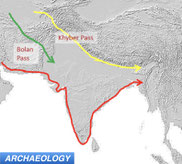
The prevailing theory within paleoanthropological circles is that Homo sapiens evolved around 200,000 years ago in eastern Africa and spread out from there. New research, however, indicates we may have to rethink our origins story.
An international group of scientists led by Jean-Jacques Hublin of the Max Planck Institute discovered fossil remains of at least five early Homo sapiens in Jebel Irhoud, Morocco. The five individuals were found in-situ with a cache of heat treated flints, which researchers were able to date through thermoluminescence. Results of the thermoluminescence testing showed the flints, and by extension the fossils, were over 300,000 years old.
Hublin, describing the find in a press release, stated,
"We used to think that there was a cradle of mankind 200 thousand years ago in east Africa, but our new data reveal that Homo sapiens spread across the entire African continent around 300 thousand years ago. Long before the out-of-Africa dispersal of Homo sapiens, there was dispersal within Africa.”
However, Hublin and his team’s findings are not universally accepted. The Journal Nature is reporting that some paleoanthropologists don’t think the fossil remains are actually from Homo sapiens because the skulls lack prominent chins and foreheads, hallmarks of our species. Hublin’s team disagrees. After conducting computed tomographic scans coupled with statistical shape analyses, the group concluded that the facial characteristics of the fossil finds are identical to modern humans, but the braincases are more elongated than our own. Study co-author Philipp Gunz of the Max Planck Institute, also describing the find in a press release, stated,
"The inner shape of the braincase reflects the shape of the brain. Our findings suggest that modern human facial morphology was established early on in the history of our species, and that brain shape, and possibly brain function, evolved within the Homo sapiens lineage.”
Unfortunately, Hublin et al. were unable to extract DNA from any of the fossils. Their work was published in the Journal Nature and can be found here. https://www.nature.com/nature/journal/v546/n7657/full/nature22336.html
Photo Caption Expanded: These are two views of a composite reconstruction of the earliest known Homo sapiens fossils from Jebel Irhoud (Morocco) based on micro computed tomographic scans of multiple original fossils. Dated to 300 thousand years ago these early Homo sapiens already have a modern-looking face that falls within the variation of humans living today. However, the archaic-looking virtual imprint of the braincase (blue) indicates that brain shape, and possibly brain function, evolved within the Homo sapiens lineage. Credit, Philipp Gunz, MPI EVA Leipzig



